Multi-Scale Analysis of the Relationship between Land Subsidence and Buildings: A Case Study in an Eastern Beijing Urban Area Using the PS-InSAR Technique
Abstract
:1. Introduction
2. Study Area and Dataset
2.1. Study Area
2.2. SAR Images and Validation Datasets
2.3. Building Properties
3. Methodology
3.1. Land Subsidence Monitoring Using the PSI Technique
3.2. Multi-Scale Analysis of the Relationship between Building Characteristics and Land Subsidence
4. Results
4.1. Land Surface Deformation Derived from the PSI Techniques and Validation
4.2. Spatiotemporal Characteristics of Land Subsidence at Each Region
4.3. Block-Scale Building Characteristics and Subsidence
4.4. Building-Scale Subsidence and Building Volume
5. Discussion
5.1. Causes of Land Subsidence at the Regional Scale
5.2. Effects of Building Characteristics on Block-Scale Subsidence Unevenness
5.3. Effects of Building Volume on Building-Scale Subsidence
6. Conclusions
- (1)
- At the regional scale, the spatiotemporal evolution of land subsidence was mainly controlled by declines in the groundwater level, compressible layer thickness, and geological faults. The spatial pattern of the land subsidence rate distribution was consistent with groundwater level contours during the two time periods, and the highest deformation rate occurred in regions I, II, and III, where the compressible clay layer thickness reached 50–70 m. Geological faults also affected the subsidence unevenness at a regional scale. The mean and SD of ground displacement increased significantly from 2003–2010 to 2010–2016 in almost all of the regions. For each region, the mean and SD of ground displacement within the blocks showed a similar spatiotemporal pattern as that within the whole region.
- (2)
- At the block scale, we analysed the relationship between the age of block construction and the deformation at the subsidence centre area (regions I, II, and III) and the area far from the subsidence centre (regions IV and V). Interestingly, we found that newly constructed blocks (constructed between 1998–2005 and after 2005) had a considerably higher spatial unevenness of ground settlement than the old blocks (constructed before 1998), especially during the time period of 2010–2016, as shown by the TerraSAR-X dataset. This pattern was more obvious for the block cluster with adjacent new and old blocks. The temporal instability of the deformation within the new blocks was also greater than that within the old blocks. For the new buildings, we found that subsidence unevenness was related to the variation in building volume within the block. Greater variations in building volume corresponded to greater subsidence unevenness. The block-scale results indicated that intense building construction within a small area could disturb the balance of stresses in the overlying strata, and thus cause differential settlement.
- (3)
- At the building scale, an analysis of 16 new blocks with a building volume range over 105 m3 demonstrated a weak positive relationship between single-building settlement and building volume in 13 blocks. However, in the remaining three blocks, we found the settlement rates of some high-rise buildings were lower than those of low-rise buildings. Single-building settlement can be caused by the combined effects of load magnitude, foundation structure, and foundation depth.
Author Contributions
Funding
Acknowledgments
Conflicts of Interest
References
- Zhu, L.; Gong, H.L.; Li, X.J.; Wang, R.; Chen, B.B.; Dai, Z.X.; Teatini, P. Land subsidence due to groundwater withdrawal in the northern Beijing plain, China. Eng. Geol. 2015, 193, 243–255. [Google Scholar] [CrossRef]
- Chen, M.; Tomás, R.; Li, Z.H.; Motagh, M.; Li, T.; Hu, L.Y.; Gong, H.L.; Li, X.J.; Yu, J.; Gong, X.L. Imaging Land Subsidence Induced by Groundwater Extraction in Beijing (China) Using Satellite Radar Interferometry. Remote Sens. 2016, 8, 468. [Google Scholar] [CrossRef]
- Chen, B.B.; Gong, H.L.; Li, X.J.; Lei, K.C.; Zhu, L.; Gao, M.L.; Zhou, C.F. Characterization and causes of land subsidence in Beijing, China. Int. J. Remote Sens. 2017, 38, 808–826. [Google Scholar] [CrossRef]
- Lei, K.C.; Luo, Y.; Chen, B.B.; Guo, G.X.; Zhou, Y. Distribution characteristics and influence factors of land subsidence in Beijing area. Geol. China 2016, 6, 2216–2228. [Google Scholar]
- Zhou, C.F.; Gong, H.L.; Chen, B.B.; Zhu, F.; Duan, G.Y.; Gao, M.L.; Lu, W. Land subsidence under different land use in the eastern Beijing plain, China 2005–2013 revealed by InSAR timeseries analysis. GISci. Remote Sens. 2016, 53, 671–688. [Google Scholar] [CrossRef]
- Zhou, C.; Gong, H.; Chen, B.; Li, J.; Gao, M.; Zhu, F.; Chen, W.; Liang, Y. InSAR Time-Series Analysis of Land Subsidence under Different Land Use Types in the Eastern Beijing Plain, China. Remote Sens. 2017, 9, 380. [Google Scholar] [CrossRef]
- Gao, M.L.; Gong, H.L.; Chen, B.B.; Zhou, C.F.; Chen, W.F.; Liang, Y.; Shi, M.; Si, Y. InSAR time-series investigation of long-term ground displacement at Beijing Capital International Airport, China. Tectonophysics 2016, 691, 271–281. [Google Scholar] [CrossRef]
- Teatini, P.; Tosi, L.; Strozzi, T.; Carbognin, L.; Cecconi, G.; Rosselli, R.; Libardo, S. Resolving land subsidence within the Venice Lagoon by persistent scatterer SAR interferometry. Phys. Chem. Earth 2012, 40–41, 72–79. [Google Scholar] [CrossRef]
- Deng, Z.; Ke, Y.H.; Gong, H.L.; Li, X.J.; Li, Z.H. Land subsidence prediction in Beijing based on PS-InSAR technique and improved Grey-Markov model. GISci. Remote Sens. 2017, 54, 797–818. [Google Scholar] [CrossRef]
- Stramondo, S.; Bozzano, F.; Marra, F.; Wegmuller, U.; Cinti, F.R.; Moro, M.; Saroli, M. Subsidence induced by urbanisation in the city of Rome detected by advanced InSAR technique and geotechnical investigations. Remote Sens. Environ. 2008, 112, 3160–3172. [Google Scholar] [CrossRef]
- Solari, L.; Ciampalini, A.; Raspini, F.; Bianchini, S.; Moretti, S. PSInSAR Analysis in the Pisa Urban Area (Italy): A Case Study of Subsidence Related to Stratigraphical Factors and Urbanization. Remote Sens. 2016, 8, 120. [Google Scholar] [CrossRef]
- Pratesi, F.; Tapete, D.; Del Ventisette, C.; Moretti, S. Mapping interactions between geology, subsurface resource exploitation and urban development in transforming cities using InSAR Persistent Scatterers: Two decades of change in Florence, Italy. Appl. Geogr. 2016, 77, 20–37. [Google Scholar] [CrossRef]
- Chen, G.; Zhang, Y.; Zeng, R.Q.; Yang, Z.K.; Chen, X.; Zhao, F.M.; Meng, X.M. Detection of land subsidence associated with land creation and rapid urbanization in the Chinese Loess Plateau using Time Series InSAR: A case study of Lanzhou New District. Remote Sens. 2018. [Google Scholar] [CrossRef]
- Tosi, L.; Strozzi, T.; Da Lio, C.; Teatini, P. Regional and local land subsidence at the Venice coastland by TerraSAR-X PSI. Proc. Int. Assoc. Hydrol. Sci. 2015, 372, 199–205. [Google Scholar] [CrossRef] [Green Version]
- Tosi, L.; Da Lio, C.; Strozzi, T.; Teatini, P. Combining L- and X-Band SAR Interferometry to Assess Ground Displacements in Heterogeneous Coastal Environments: The Po River Delta and Venice Lagoon, Italy. Remote Sens. 2016, 8, 308. [Google Scholar] [CrossRef]
- Maghsoudi, Y.; van der Meer, F.; Hecker, C.; Perissin, D.; Saepuloh, A. Using PS-InSAR to detect surface deformation in geothermal areas of West Java in Indonesia. Int. J. Appl. Earth Obs. Geoinform. 2018, 64, 386–396. [Google Scholar] [CrossRef]
- Liao, M.S.; Pei, Y.Y.; Wang, H.M.; Fang, Z.L.; Wei, L.H. Subsidence Monitoring in Shanghai Using the PSInSAR Technique. Shanghai Land Resour. 2012, 33, 5–10. [Google Scholar]
- Qin, X.Q.; Yang, M.S.; Wang, H.M.; Yang, T.L.; Lin, J.X.; Liao, M.S. Application of High-resolution PS-InSAR in Deformation Characteristic Probe of Urban Rail Transit. Acta Geod. Geophys. Sin. 2016, 45, 713–721. [Google Scholar]
- Chen, W.F.; Gong, H.L.; Chen, B.B.; Liu, K.S.; Gao, M.L.; Zhou, C.F. Spatiotemporal evolution of land subsidence around a subway using InSAR time-series and the entropy method. GISci. Remote Sens. 2017, 54, 78–94. [Google Scholar] [CrossRef]
- Solari, L.; Ciampalini, A.; Raspini, F.; Bianchini, S.; Zinno, I.; Bonano, M.; Manunta, M.; Moretti, S.; Casagli, N. Combined Use of C- and X-Band SAR Data for Subsidence Monitoring in an Urban Area. Geosciences 2017, 7, 21. [Google Scholar] [CrossRef]
- Tapete, D.; Morelli, S.; Fanti, R.; Casagli, N. Localising deformation along the elevation of linear structures: An experiment with spaceborne InSAR and RTK GPS on the Roman Aqueducts in Rome, Italy. Appl. Geogr. 2015, 58, 65–83. [Google Scholar] [CrossRef] [Green Version]
- Tang, Y.; Cui, Z.; Wang, J.; Yan, L.; Yan, X. Application of grey theory-based model to prediction of land subsidence due to engineering environment in Shanghai. Environ. Geol. 2008, 55, 583–593. [Google Scholar] [CrossRef]
- Cui, Z.; Tang, Y.; Yan, X. Centrifuge modeling of land subsidence caused by the high-rise building group in the soft soil area. Environ. Earth Sci. 2010, 59, 1819–1826. [Google Scholar] [CrossRef]
- Xu, Y.; Ma, L.; Du, Y.; Shen, S. Analysis of urbanisation-induced land subsidence in Shanghai. Nat. Hazards 2012, 63, 1255–1267. [Google Scholar] [CrossRef]
- Chen, B.B.; Gong, H.L.; Li, X.J.; Lei, K.C.; Ke, Y.H.; Duan, G.Y.; Zhou, C.F. Spatial correlation between land subsidence and urbanization in Beijing, China. Nat. Hazards 2015, 75, 2637–2652. [Google Scholar] [CrossRef]
- Chen, B.B.; Gong, H.L.; Li, X.J.; Lei, K.C.; Gao, M.L.; Zhou, C.F.; Ke, Y.H. Spatial–temporal evolution patterns of land subsidence with different situation of space utilization. Nat. Hazards 2015, 77, 1765–1783. [Google Scholar] [CrossRef]
- Jiao, S.; Yu, J.; Milas, A.S.; Li, X.; Liu, L. Assessing the Impact of Building Volume on Land Subsidence in the Central Business District of Beijing with SAR Tomography. Can. J. Remote Sens. 2017, 43, 177–193. [Google Scholar] [CrossRef]
- Hooper, A.; Zebker, H.; Segall, P.; Kampes, B. A new method for measuring deformation on volcanoes and other natural terrains using InSAR persistent scatterers. Geophys. Res. Lett. 2004, 31. [Google Scholar] [CrossRef] [Green Version]
- Ferretti, A.; Prati, C.; Rocca, F. Nonlinear subsidence rate estimation using permanent scatterers in differential SAR interferometry. IEEE Trans. Geosci. Remote Sens. 2000, 38, 2202–2212. [Google Scholar] [CrossRef]
- Perissin, D.; Rocca, F. High-accuracy urban DEM using permanent scatterers. IEEE Trans. Geosci. Remote Sens. 2006, 44, 3338–3347. [Google Scholar] [CrossRef]
- Ruiz-Armenteros, A.M.; Bakon, M.; Lazecky, M.; Delgado, J.M.; Sousa, J.J.; Perissin, D.; Caro-Cuenca, M. Multi-Temporal InSAR Processing Comparison in Presence of High Topography. Procedia Comput. Sci. 2016, 100, 1181–1190. [Google Scholar] [CrossRef]
- Çomut, F.C.; Ustun, A.; Lazecky, M.; Aref, M.M. Multi band InSAR analysis of subsidence development based on the long period time series. Int. Arch. Photogramm. Remote Sens. Spat. Inf. Sci. 2015, 40, 115–121. [Google Scholar] [CrossRef]
- Wu, A. Chinese Institute of Geological Environment Monitoring. China Groundwater Level Yearbook for Geo-Environmental Monitoring; China Land Press: Beijing, China, 2014; pp. 154–196. ISBN 9787802463813. [Google Scholar]
- Dong, S.; Smsonov, S.; Yin, H.; Ye, S.; Cao, Y. Time-series analysis of subsidence associated with rapid urbanization in Shanghai, China measured with SBAS InSAR method. Environ. Earth Sci. 2014, 72, 677–691. [Google Scholar] [CrossRef]

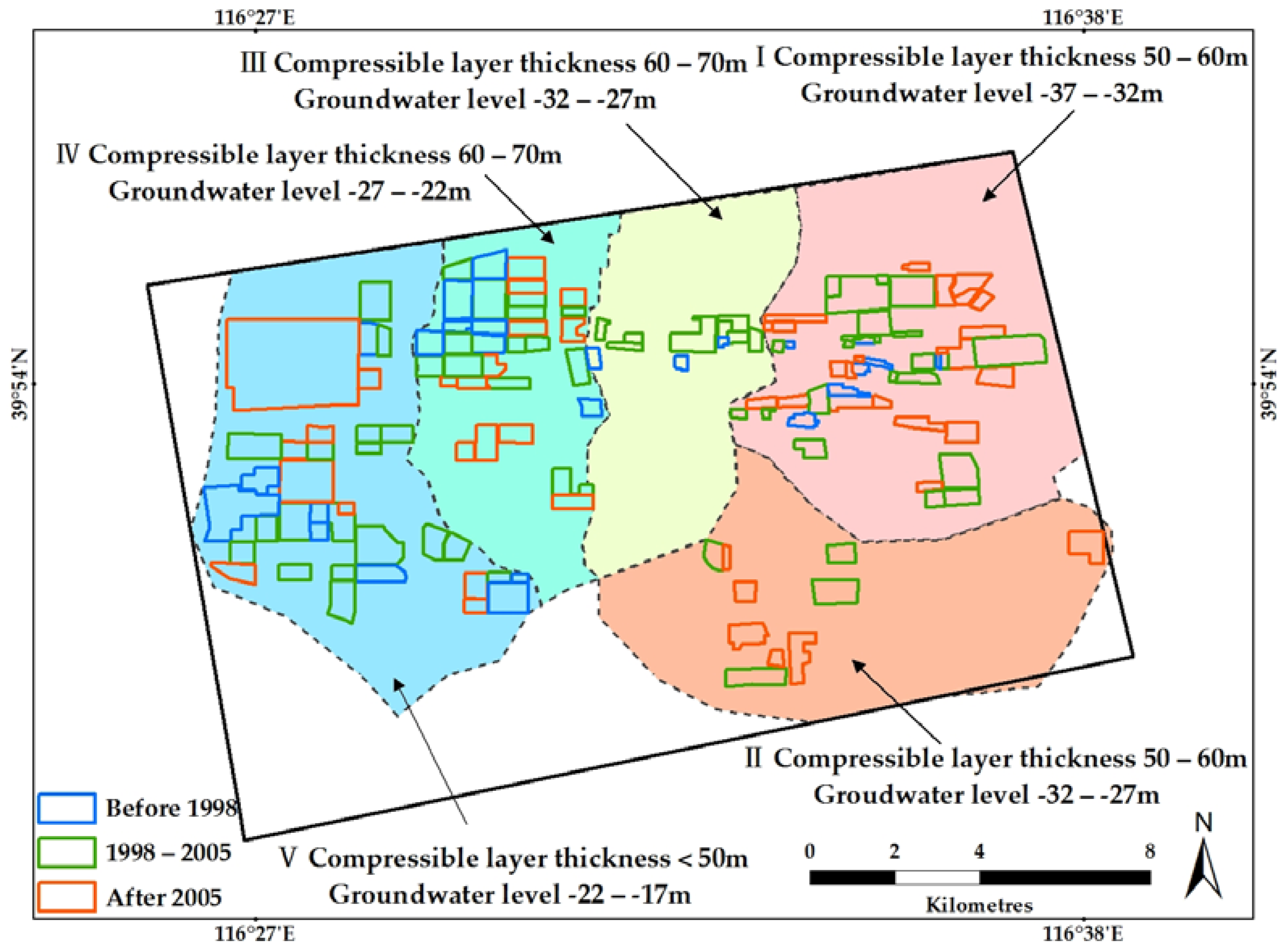
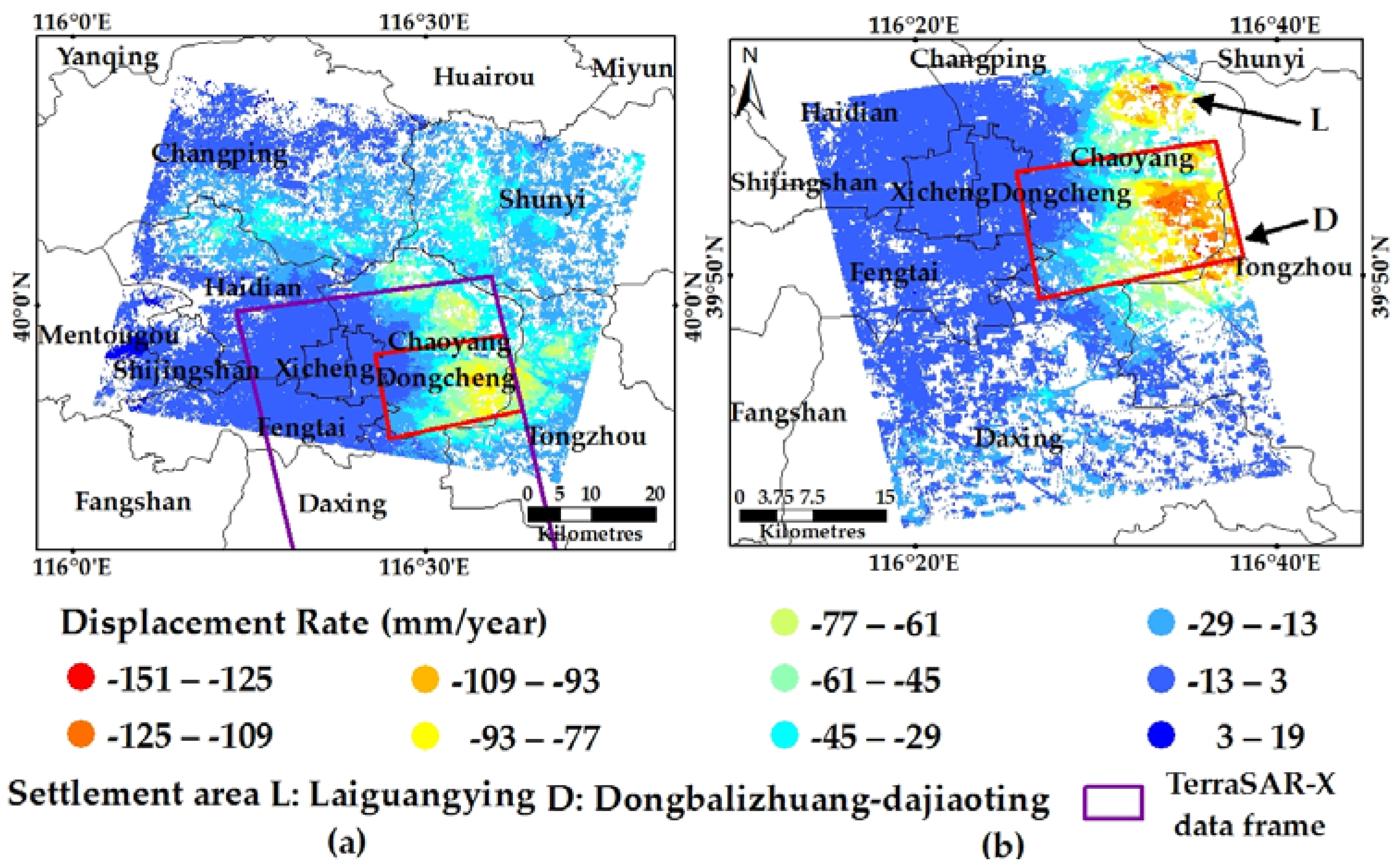

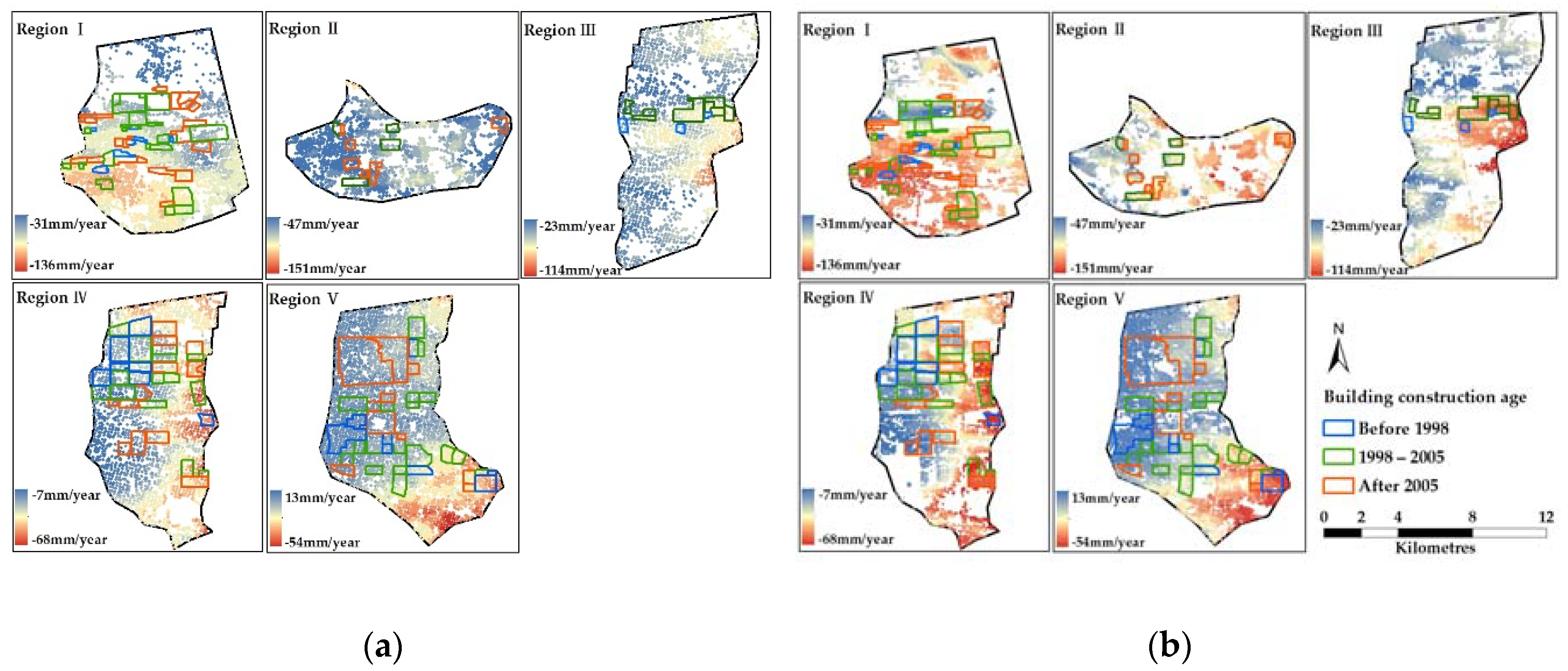
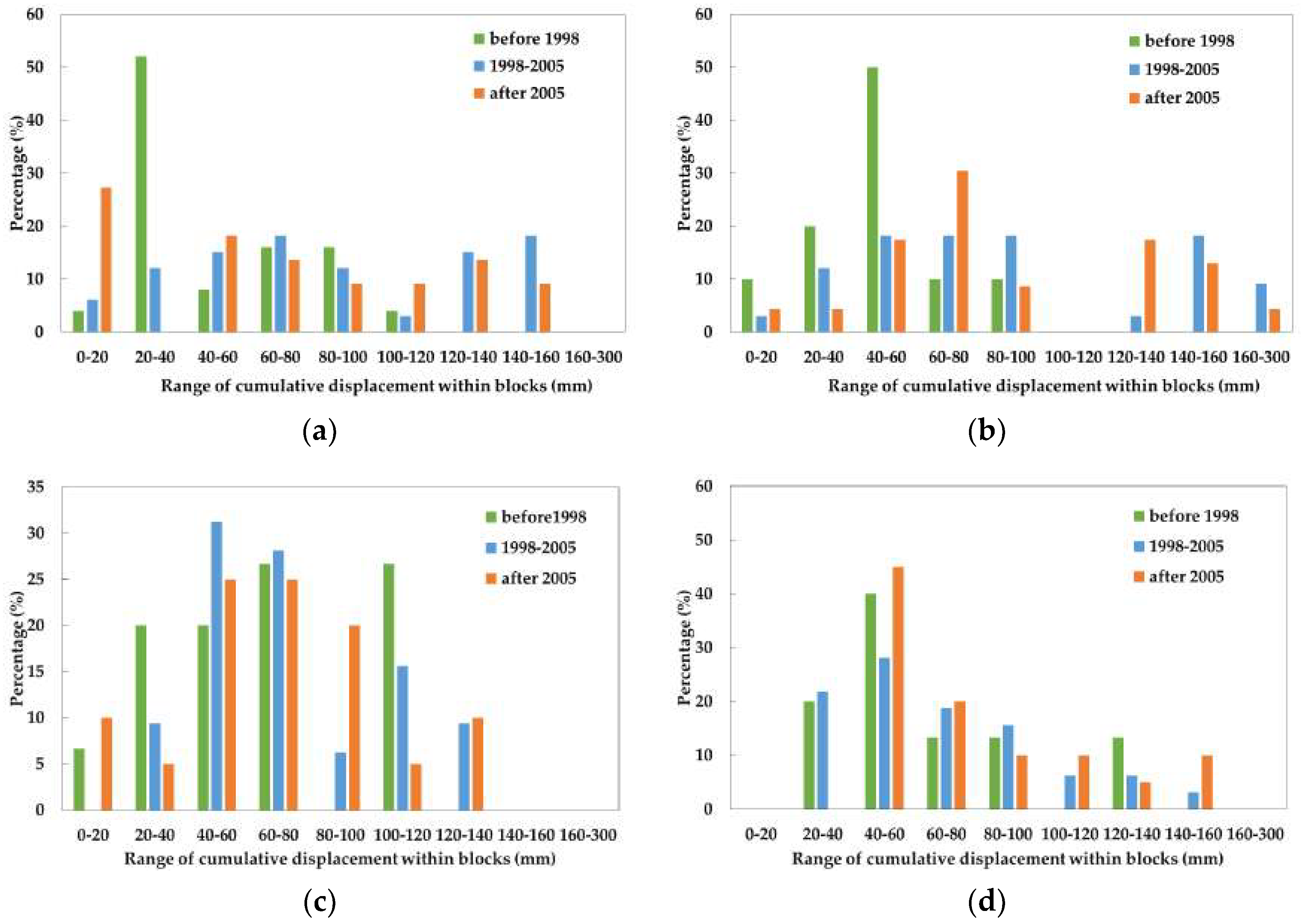

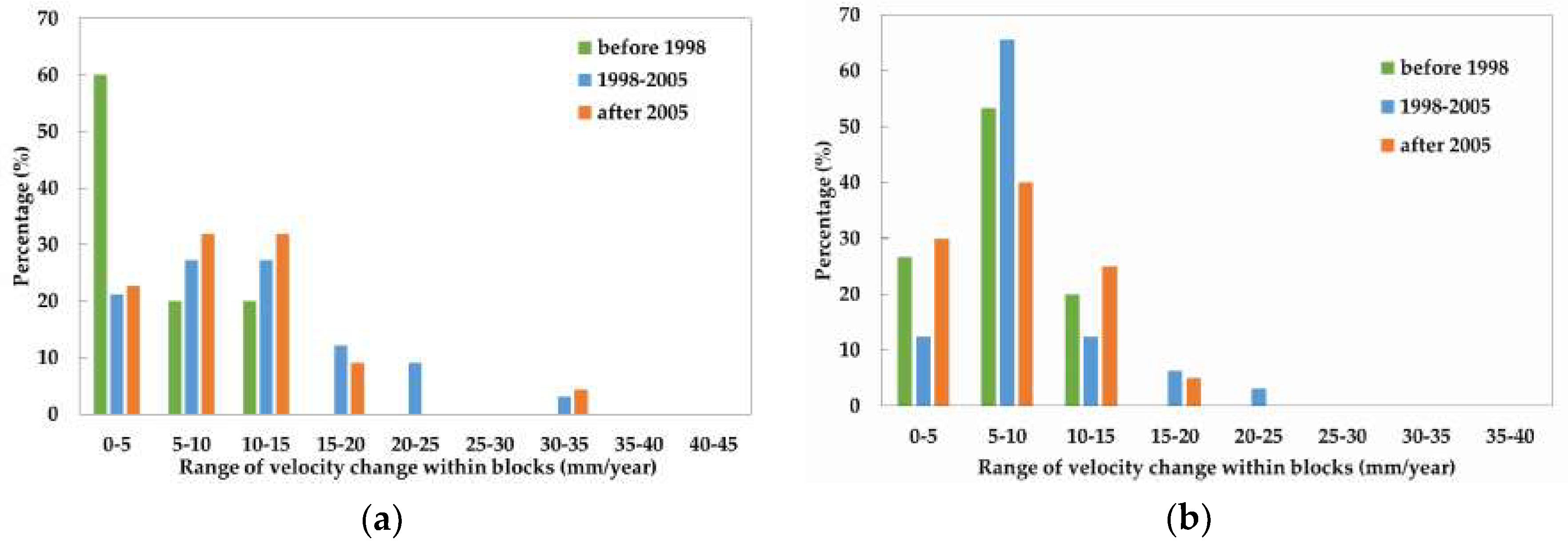
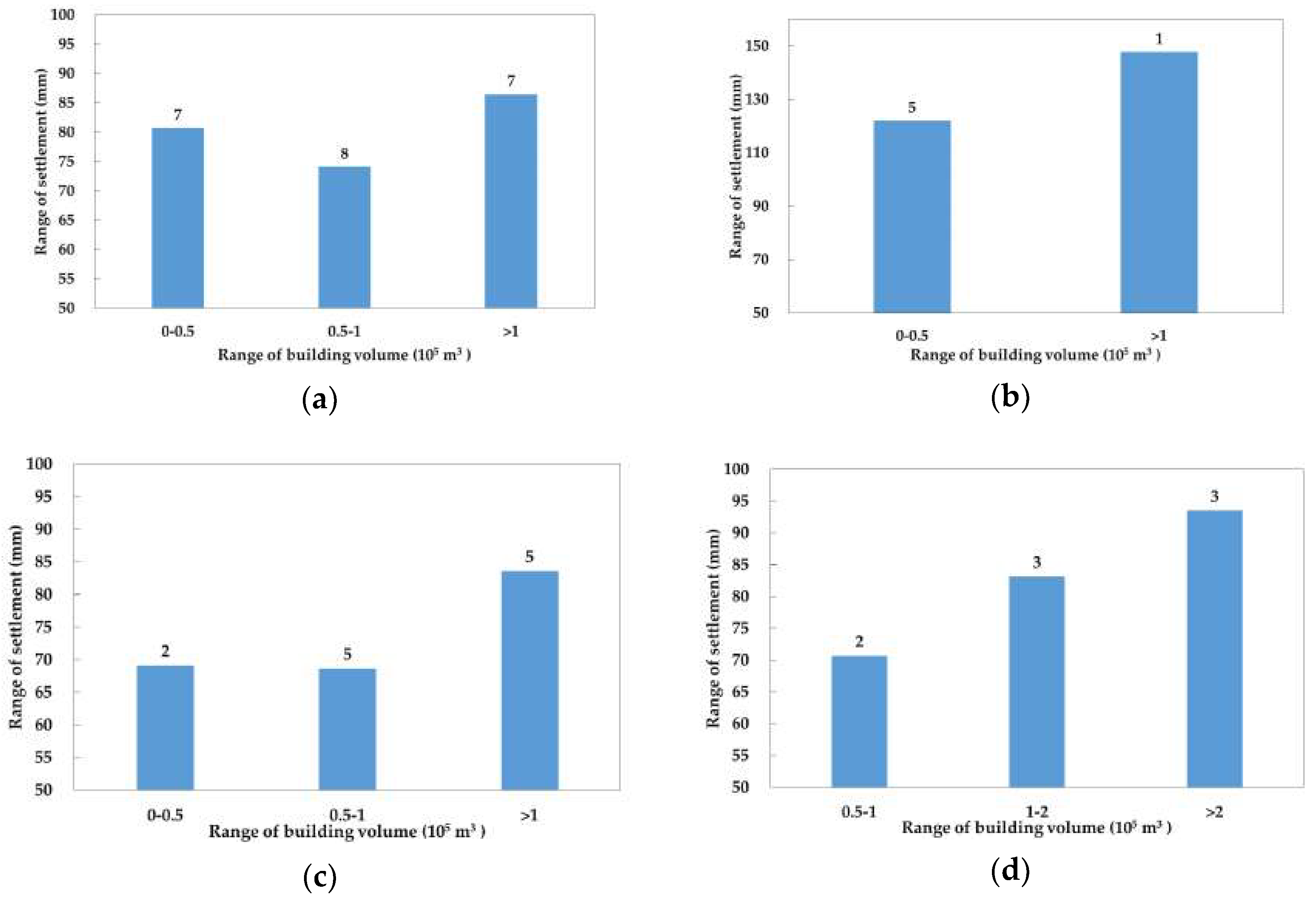
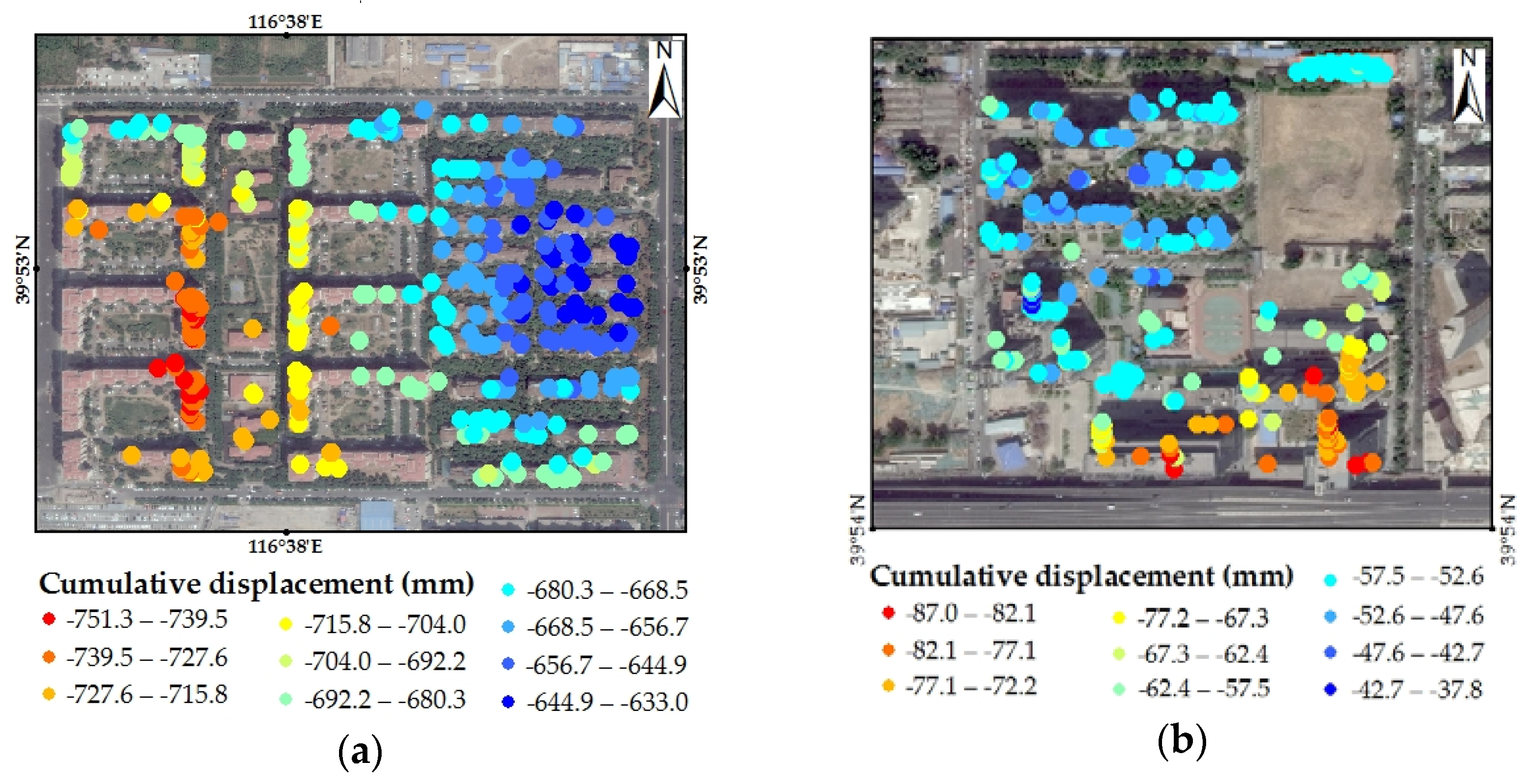
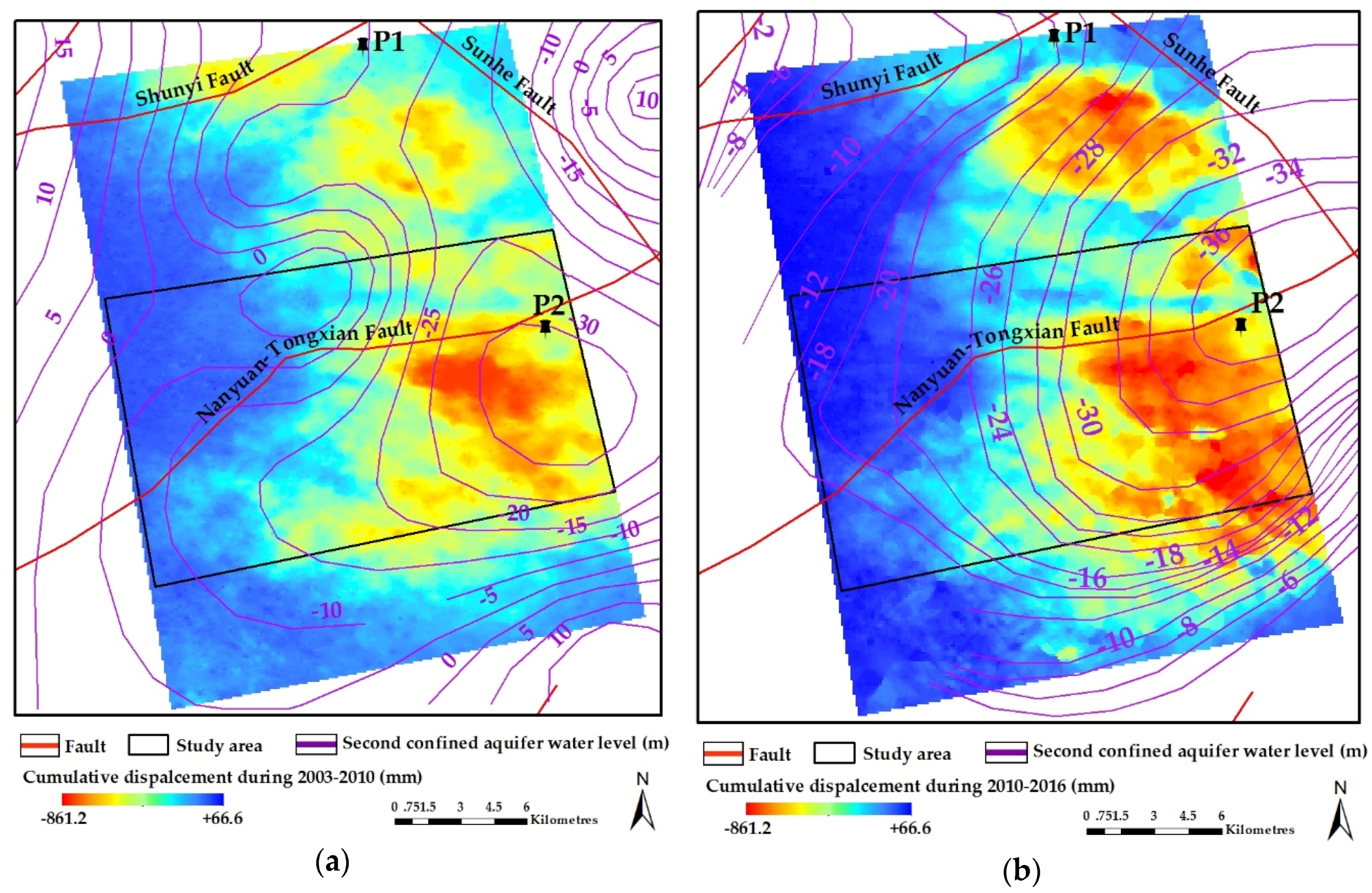

| Region | I | II | III | IV | V | |
|---|---|---|---|---|---|---|
| Compressible Layer Thickness (m) | 50–60 | 50–60 | 60–70 | 60–70 | <50 | |
| Groundwater Level (m) at Second Confined Aquifer | −37–32 | −32–−27 | −32–−27 | −27–−22 | −22–−17 | |
| Number of Blocks | Before 1998 | 7 | 0 | 3 | 7 | 8 |
| 1998–2005 | 21 | 4 | 8 | 13 | 19 | |
| After 2005 | 22 | 6 | 0 | 12 | 8 | |
| Total | 50 | 10 | 11 | 32 | 35 | |
| Region | I | II | III | IV | V |
|---|---|---|---|---|---|
| Total Number of PS points | 3288 | 2305 | 2103 | 2520 | 4513 |
| Mean Deformation Rate of PS points (mm/year) | −75.2 | −68.1 | −53.8 | −26.4 | −13.8 |
| SD of Deformation Rate of PS Points (mm/year) | 16.7 | 11.0 | 11.9 | 10.6 | 8.5 |
| Number of PS Points within Blocks | 975 | 261 | 254 | 968 | 1727 |
| Mean Deformation Rate within Blocks (mm/year) | −69.6 | −64.8 | −60.1 | −25.9 | −10.8 |
| SD of Deformation Rate within Blocks (mm/year) | 20.2 | 8.6 | 10.4 | 9.4 | 5.7 |
| Region | I | II | III | IV | V |
|---|---|---|---|---|---|
| Total Number of PS Points | 35,159 | 20,743 | 18,348 | 29,687 | 59,135 |
| Mean Deformation Rate of PS Points (mm/year) | −93.1 | −94.0 | −64.1 | −30.4 | −13.6 |
| SD of Deformation Rate of PS Points (mm/year) | 22.3 | 16.4 | 18.4 | 13.4 | 10.7 |
| Number of PS Points within Blocks | 15,023 | 5710 | 2527 | 16,419 | 25,978 |
| Mean Deformation Rate within Blocks (mm/year) | −89.0 | −91.6 | −82.0 | −30.0 | −11.2 |
| SD of Deformation Rate within Blocks (mm/year) | 25.2 | 12.4 | 12.9 | 13.2 | 8.9 |
| Region | Construction age (N) | (mm) | (mm/year) | (mm) | (mm/year) | ||
|---|---|---|---|---|---|---|---|
| 2003–2010 | 2010–2016 | 2003–2010 | 2010–2016 | ||||
| I–III | Before 1998 (10) | 574.3 | 612.8 | 17.5 | 52.1 | 47.7 | 5.8 |
| 1998–2005 (33) | 596.9 | 552.9 | 14.5 | 86.2 | 93.2 | 11.0 | |
| After 2005 (28) * | 563.2 * | 578.6 | 15.8 | 82.1 * | 92.5 | 10.5 | |
| IV, V | Before 1998 (15) | 144.8 | 130.2 | 7.4 | 63.3 | 64.5 | 7.0 |
| 1998–2005 (32) | 165.8 | 126.7 | 6.1 | 70.1 | 73.7 | 7.2 | |
| After 2005 (20) | 176.2 | 134.6 | 6.2 | 68.9 | 78.8 | 8.7 | |
| Region | I | II | ||||||
|---|---|---|---|---|---|---|---|---|
| a | −149.5 | −36.0 | −216.4 | −17.9 | 0.35 | −4.9 | −1.8 | −10.5 |
| b | −335.4 | −366.5 | −319.6 | −841.1 | −840.4 | −400.2 | −665.1 | −679.0 |
| R2 | 0.43 | 0.10 | 0.12 | 0.23 | 0.21 | 0.11 | 0.11 | 0.35 |
| Region | IV | V | ||||||
| a | 11.4 | −5.80 | −9.4 | −7.8 | −16.5 | 4.5 | −6.2 | −10.0 |
| b | −165.5 | −113.9 | −66.8 | −280.9 | −83.0 | −69.9 | −48.6 | −45.7 |
| R2 | 0.12 | 0.10 | 0.15 | 0.24 | 0.13 | 0.24 | 0.08 | 0.33 |
© 2018 by the authors. Licensee MDPI, Basel, Switzerland. This article is an open access article distributed under the terms and conditions of the Creative Commons Attribution (CC BY) license (http://creativecommons.org/licenses/by/4.0/).
Share and Cite
Yang, Q.; Ke, Y.; Zhang, D.; Chen, B.; Gong, H.; Lv, M.; Zhu, L.; Li, X. Multi-Scale Analysis of the Relationship between Land Subsidence and Buildings: A Case Study in an Eastern Beijing Urban Area Using the PS-InSAR Technique. Remote Sens. 2018, 10, 1006. https://doi.org/10.3390/rs10071006
Yang Q, Ke Y, Zhang D, Chen B, Gong H, Lv M, Zhu L, Li X. Multi-Scale Analysis of the Relationship between Land Subsidence and Buildings: A Case Study in an Eastern Beijing Urban Area Using the PS-InSAR Technique. Remote Sensing. 2018; 10(7):1006. https://doi.org/10.3390/rs10071006
Chicago/Turabian StyleYang, Qin, Yinghai Ke, Dongyi Zhang, Beibei Chen, Huili Gong, Mingyuan Lv, Lin Zhu, and Xiaojuan Li. 2018. "Multi-Scale Analysis of the Relationship between Land Subsidence and Buildings: A Case Study in an Eastern Beijing Urban Area Using the PS-InSAR Technique" Remote Sensing 10, no. 7: 1006. https://doi.org/10.3390/rs10071006




